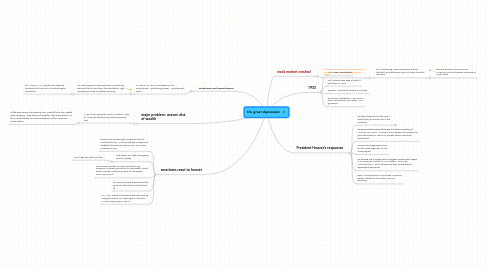the great depression
by curtis watson


1. americans react to hoover
1.1. Hoover was increasingly unpopular, but he continued to try... • he persuaded Congress to establish the RECONSTRUCTION FINANCE CORPORATION
1.2. had power to make emergency loans to banks
1.2.1. but it was too little too late…
1.3. and Hoover wouldn't involve himself in any programs of direct gov'tal aid to individuals -didn't want to erode Americans sense of "RUGGED INDIVIDUALISM"
1.4. EX: Dairy farmers frustrated w/low price of milk refuse to sell (dump it)
1.5. EX: WW1 veterans (pensions discontinued by congress) march on Washington = BONUS MARCH (by BONUS ARMY)
2. productivity and unemployment
2.1. in 1920's U.S. Eco. was based on the productivity – purchasing power - employment cycle
2.1.1. for many goods to be produced , purchasing demand had to be there: this resulted in high employment and a healthy economy
2.1.1.1. b/n 1924-27, U.S. productive capacity doubled but it was b/c of technological innovation
3. major problem: uneven dist. of wealth
3.1. 0.1% at top owned as much as bottom 42% of American families (42% below poverty line)
3.1.1. of the 58% above the poverty line, most fell into the middle class category - they were not wealthy; they had jobs b/c of the industrialization & consumerization of the American market place
4. stock market crashed
4.1. the public invests in cos. by purchasing stocks; in return for this they expect a profit
4.1.1. b/c of booming 1920's economy, $ were plentiful, so banks were quick to make loans to investors
4.1.1.1. this was known as BUYING ON MARGIN, and the balance was paid at a later date
5. President Hoover’s responses
5.1. he didn't believe that the gov't should play an active role in the economy
5.1.1. New node
